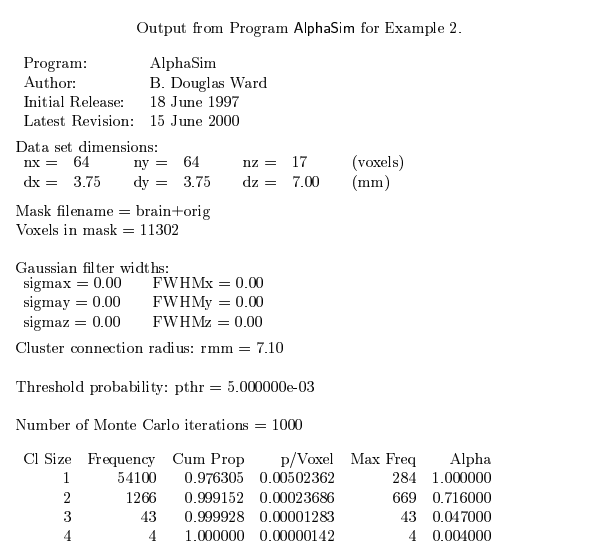關於Reho的統計其中一個部分
46 views
Skip to first unread message
love624girl
May 9, 2017, 4:35:03 AM5/9/17
to 成大心智影像研究中心-線上諮詢服務
各位學者:
您好,我目前在處理資料時遇到技術上及知識上不足的問題,希望能找到解答。
1.AlphaSim是什麼?
跟主持人討論時被提及要使用alphasim去校正,但我只有聽過及在paper裡看過,不是很懂這個校正...
上網搜尋一輪後,目前正在閱讀https://afni.nimh.nih.gov/pub/dist/doc/manual/AlphaSim.pdf ,
但一怕理解錯誤,二怕來不及...所以還是來詢問...
以上
葉丁瑞
May 9, 2017, 5:05:02 AM5/9/17
to love624girl, 成大心智影像研究中心-線上諮詢服務
您好

alphaSim是統計校正的一種,如同你找的document.內容描述到可以變更mask和校正前p-value,再加上你spatial smoothing (FWHM)
會跑出一個數值報表,以p.11( 如下)

此例子,說明.在p-value=0.005情況下, FWHM為0,clustersize為3時,校正後p-value為0.047.
cue陳德祐老師,不知道有沒有地方沒有說明清楚的.
丁瑞
Yeh Ting-Jui
Member of Mind Research and Imaging Center, National Cheng Kung University
No.1,University Road,Tainan City 701,Taiwan
+886(6)2353535#6269
Fax: +886(6)2004848
Email : dingruey88@gmail.com
--
這是 Google 網上論壇針對「成大心智影像研究中心-線上諮詢服務」群組發送的訂閱通知郵件。
如要取消訂閱這個群組並停止接收來自這個群組的郵件,請傳送電子郵件到 fmrincku+unsubscribe@googlegroups.com。
如需更多選項,請前往:https://groups.google.com/d/optout。
Der-Yow Chen
May 9, 2017, 9:35:53 PM5/9/17
to 葉丁瑞, love624girl, 成大心智影像研究中心-線上諮詢服務
丁瑞已經大致說明了實際跑出來的結果,
我再簡要補充解釋一下它的內涵。
AlphaSim校正方式主要是基於Monte Carlo 模擬,我再簡要補充解釋一下它的內涵。
當你設定每個voxel p value threhold為某值(例如在上例中是0.005),
在null hypothesis時,根據你的brain mask所使用的實際voxel總數,
隨機會產生某個大小的cluster的機率 (也就是type I error, alpha)
由於它是用模擬的方式不斷重覆抽樣去計算alpha值,因此叫做AlphaSim。
而在模擬的過程可以調整許多參數,例如iterations是模擬抽樣的次數,
在上例中是1000次,其實有點少,
可以試著做10000次或更多,會比較精準,但就會模擬比較久的時間。
你也不一定要給它brain mask, 而指定x, y, z三個方向的voxel size & number,
以及spatial smoothing的FWHM等等。
然而早期AlphaSim程式有一些小bug,去年的這篇paper引起喧然大波:
http://www.pnas.org/content/early/2016/06/27/1602413113
各大媒體用非常聳動的標題,
質疑過去15年間所有fMRI的4萬篇研究論文有很多都受到影響。
其實學界討論是認為沒有那麼嚴重,AFNI團隊也早就修改了這個bug
而且建議最好使用另一個程式3dClustSim:
https://afni.nimh.nih.gov/pub/dist/doc/program_help/3dClustSim.html
我個人認為只要小心使用就沒問題。
陳德祐敬上
love624girl
May 10, 2017, 7:25:31 AM5/10/17
to 成大心智影像研究中心-線上諮詢服務
謝謝兩位學者的解答,讓我更理解它的運作
也謝謝陳老師的提醒,確實有看到3dClustSim (AFNI的網頁請人以後不要再使用alphasim)
非常感謝您們的答覆!(鞠躬
love624girl於 2017年5月9日星期二 UTC+8下午4時35分03秒寫道:
非常感謝您們的答覆!(鞠躬
love624girl於 2017年5月9日星期二 UTC+8下午4時35分03秒寫道:
love624girl
May 10, 2017, 7:37:11 AM5/10/17
to 成大心智影像研究中心-線上諮詢服務
陳老師:
love624girl於 2017年5月9日星期二 UTC+8下午4時35分03秒寫道:
您好,關於iterations的次數,想請問您提到的1000次有點少,與10000次的這個數字...也是來自於許多論文的參考?還是它有其他的定義標準?
(看到大多文章定在默認的1000,但時間靠進今年的文章有一些定在10000...~"~)
以上
love624girl於 2017年5月9日星期二 UTC+8下午4時35分03秒寫道:
Der-Yow Chen
May 10, 2017, 8:45:43 AM5/10/17
to love624girl, 成大心智影像研究中心-線上諮詢服務
iteration的次數越多,理論上對於機率的估計應該會更好,但真的比較花時間。
這類似於 p value的顯著水準要放在0.05, 0.01, 還是0.001,並沒有絕對。
當然一個研究若能通過越嚴格的標準,也就越有說服力。
這類似於 p value的顯著水準要放在0.05, 0.01, 還是0.001,並沒有絕對。
當然一個研究若能通過越嚴格的標準,也就越有說服力。
--
Chun-Chia Kung
May 24, 2017, 11:11:08 AM5/24/17
to chendy, 葉丁瑞, love624girl, Fmrincku
hi all:
On May 10, 2017, at 9:35 AM, Der-Yow Chen <che...@mail.ncku.edu.tw> wrote:丁瑞已經大致說明了實際跑出來的結果,AlphaSim校正方式主要是基於Monte Carlo 模擬,
我再簡要補充解釋一下它的內涵。
當你設定每個voxel p value threhold為某值(例如在上例中是0.005),
在null hypothesis時,根據你的brain mask所使用的實際voxel總數,
隨機會產生某個大小的cluster的機率 (也就是type I error, alpha)
由於它是用模擬的方式不斷重覆抽樣去計算alpha值,因此叫做AlphaSim。
而在模擬的過程可以調整許多參數,例如iterations是模擬抽樣的次數,
在上例中是1000次,其實有點少,
可以試著做10000次或更多,會比較精準,但就會模擬比較久的時間。
你也不一定要給它brain mask, 而指定x, y, z三個方向的voxel size & number,
以及spatial smoothing的FWHM等等。
然而早期AlphaSim程式有一些小bug,去年的這篇paper引起喧然大波:
http://www.pnas.org/content/early/2016/06/27/1602413113
各大媒體用非常聳動的標題,
質疑過去15年間所有fMRI的4萬篇研究論文有很多都受到影響。
其實學界討論是認為沒有那麼嚴重,AFNI團隊也早就修改了這個bug
而且建議最好使用另一個程式3dClustSim:
https://afni.nimh.nih.gov/pub/dist/doc/program_help/3dClustSim.html
我個人認為只要小心使用就沒問題。
陳德祐敬上
剛看到 AFNI team 在 2017 Apr 的 Brain Connectivity 上對這個問題的進一步回應。cheers, 俊嘉
Recent reports of inflated false-positive rates (FPRs) in FMRI group analysis tools by Eklund and associates in 2016 have become a large topic within (and outside) neuroimaging. They concluded that existing parametric methods for determining statistically significant clusters had greatly inflated FPRs (“up to 70%,” mainly due to the faulty assumption that the noise spatial autocorrelation function is Gaussian shaped and stationary), calling into question potentially “countless” previous results; in contrast, nonparametric methods, such as their approach, accurately reflected nominal 5% FPRs. They also stated that AFNI showed “particularly high” FPRs compared to other software, largely due to a bug in 3dClustSim. We comment on these points using their own results and figures and by repeating some of their simulations. Briefly, while parametric methods show some FPR inflation in those tests (and assumptions of Gaussian-shaped spatial smoothness also appear to be generally incorrect), their emphasis on reporting the single worst result from thousands of simulation cases greatly exaggerated the scale of the problem. Importantly, FPR statistics depends on “task” paradigm and voxelwise p value threshold; as such, we show how results of their study provide useful suggestions for FMRI study design and analysis, rather than simply a catastrophic downgrading of the field's earlier results. Regarding AFNI (which we maintain), 3dClustSim's bug effect was greatly overstated—their own results show that AFNI results were not “particularly” worse than others. We describe further updates in AFNI for characterizing spatial smoothness more appropriately (greatly reducing FPRs, although some remain >5%); in addition, we outline two newly implemented permutation/randomization-based approaches producing FPRs clustered much more tightly about 5% for voxelwise p ≤ 0.01.
您好alphaSim是統計校正的一種,如同你找的document.內容描述到可以變更mask和校正前p-value,再加上你spatial smoothing (FWHM)會跑出一個數值報表,以p.11( 如下)
<螢幕快照 2017-05-09 下午4.58.05.png>
如要取消訂閱這個群組並停止接收來自這個群組的郵件,請傳送電子郵件到 fmrincku+u...@googlegroups.com。
如需更多選項,請前往:https://groups.google.com/d/optout。
Reply all
Reply to author
Forward
0 new messages
